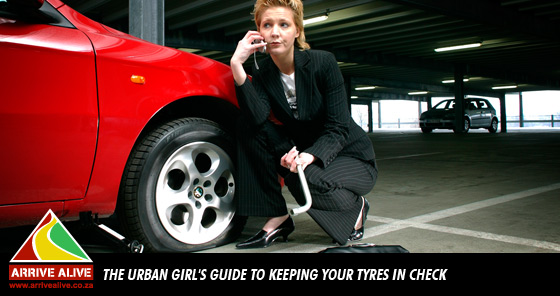You’ve ticked all the right boxes when it comes to making sure that everything is seamlessly in place for that end of year holiday, but can you say the same for your tyres? Tyre safety may not be as exciting as splashing out on your 100th pair of designer shoes, but it is well worth the time and money. After all, failing to make sure your car has got the right “shoes” can turn your dream holiday into a roadside disaster.
Here are some tyre safety basics to look out for, thanks to Tiger Wheel & Tyre:
Take note of your tread
We all have a favourite pair of shoes that we wear until the heels have eroded beyond recognition of their former glory. Just like the heels of your shoes, tyres have tread that wears down with driving. The more worn your tyres, the less traction and grip you will have on the road, meaning your braking distance will increase and you are more likely to skid when driving in the rain. In fact, the legal tread depth limit in South Africa is a minimum of 1mm across the entire circumference of the tyre. Not sure whether you are legal, ask a wheel and tyre professional to point out the tread wear indicators on your tyres.
Under pressure
Wearing shoes that are too tight or too loose can be fashion suicide or just plain unpleasant. The right tyre pressure can also be the difference between life and death. Don’t assume the pressure is two bars which a lot of ladies do when we chant “two please” to the friendly petrol attendant. Each car comes with recommended pressures which you will find in the sill of the driver’s door or inside the fuel cap. Rather take the time to check these and make sure the pressure is just right. Over inflated tyres erode quickly at their centre, while under inflated tyres wear on the outsides quicker. Under inflated tyres overheat easily and can cause tyre bursts which is notorious for road fatalities.
The other tyre
Every fashionista knows to keep a spare pair of shoes in the boot of their car in case of a mishap. Before you get on your way, also check that you have a spare tyre and that it is inflated to the right pressure, and has the right amount of tread – at least 1mm – for a safe journey. If your car is fitted with run-flat tyres you won’t have a spare, see “Run-flats vs Normal” below.
Balancing act
Staying in your lane is a basic rule, but neglecting the balancing and alignment of your wheels can make you lose your step. If your car is shaking or pulling to one side while driving, you need to get your wheels balanced and aligned. Sometimes it’s very subtle so make sure you check your wheel balancing and alignment every 10 000 kms or before every major trip. This not only improves the handling of your car but also extends the tread life of your tyres. The more care you take to look after your tyres, the longer they will last which means you have more money to spend on your summer wardrobe.
These are just some of the basics for keeping your tyres in check and staying safe on the roads. We suggest that you take your car to your nearest wheel and tyre specialist like Tiger Wheel & Tyre for a free safety check so that all you need to worry about this festive season is having a good time and showing off those sexy heels. Remember, it’s better to be a fashion victim than it is to be a road accident statistic.
Replacing your tyres: If you have to replace a tyre due to worn tread or damage, never replace only 1 tyre at a time as this will affect the handling of your car. Always replace 2 or 4 tyres.
Repairing your tyres: If you need to repair a tyre, don’t take any short cuts with a temporary plug and only have it repaired at a reputable tyre dealer.
For more information on tyre safety check out Tiger Wheel & Tyre’s Top Tyre Tips: http://www.twt.co.za/8/top-tips/
Know the difference:
Nitrogen vs Air
Tyres run cooler which means they last longer. Tyres running on nitrogen don’t lose pressure as quickly as tyres inflated with air. Inflating your tyres with nitrogen can extend tyre life by up to 20%.
Run-flat vs Normal
Run-flat tyres are designed to continue driving after the tyre has been punctured so that you don’t have to stop at the side of the road and put on a spare. Run flat tyres should not be repaired.
Heavy load vs Light load
Heavy loads put extra strain on your tyres, so if your car is jam-packed with luggage make sure you adjust the tyre pressure. Tyre failure can occur due to overloading, so check your owner’s manual for recommended tyre pressures for “heavy loads” before you pack everything but the kitchen sink.
We would like to urge all vehicle owners to pay close attention to tyre safety and view the following sections:
